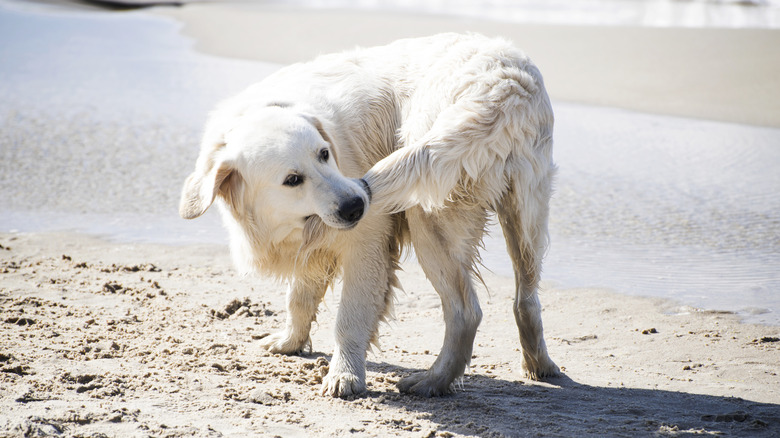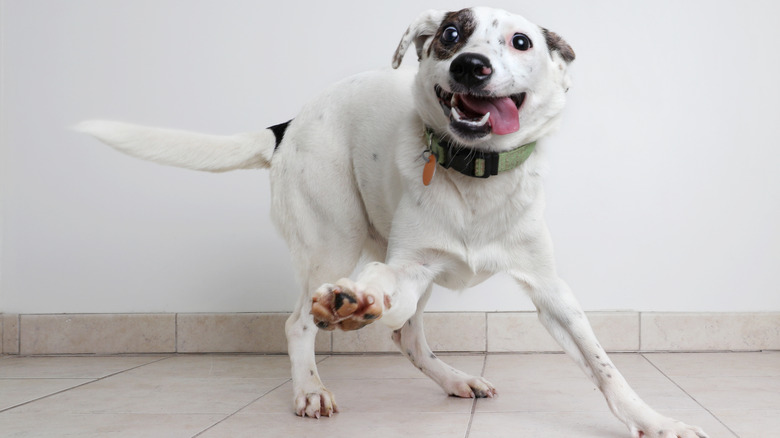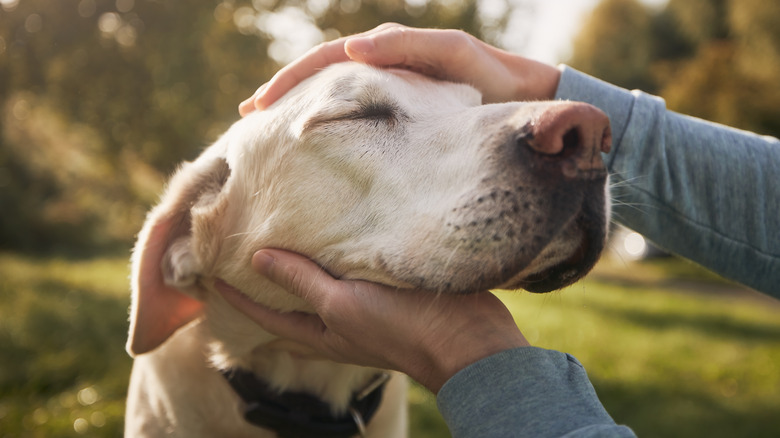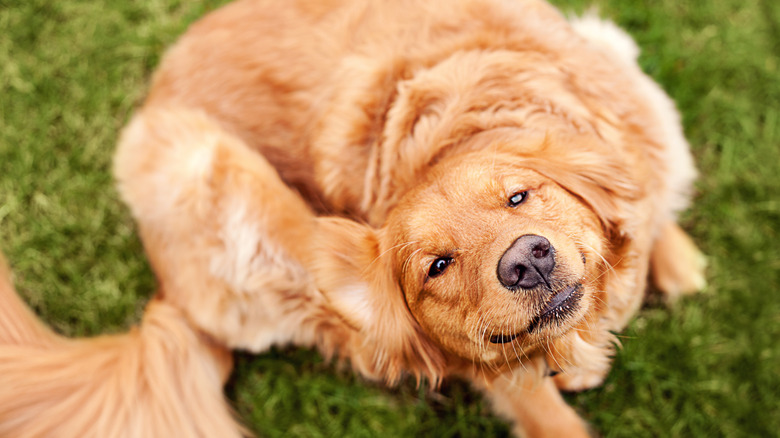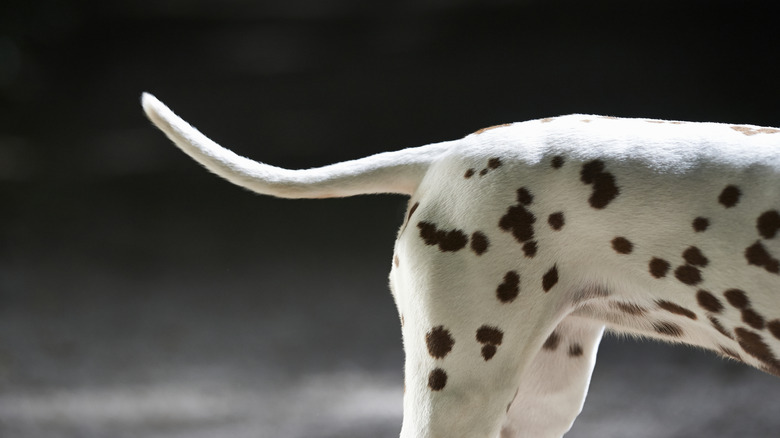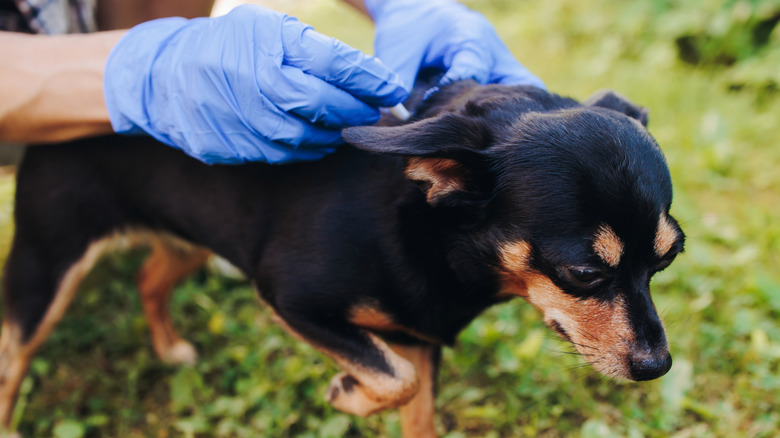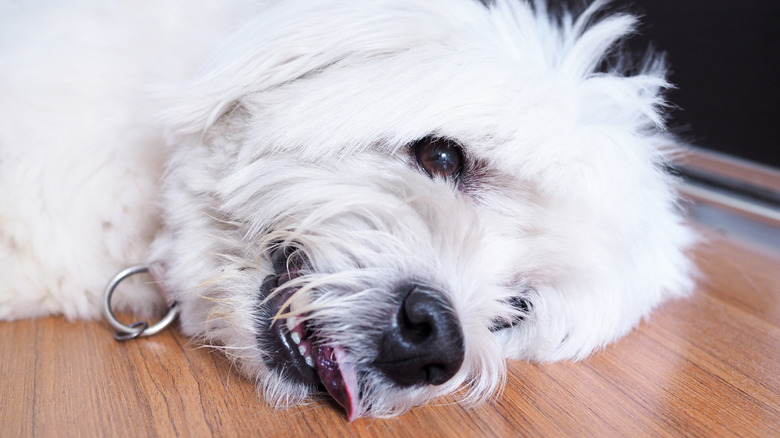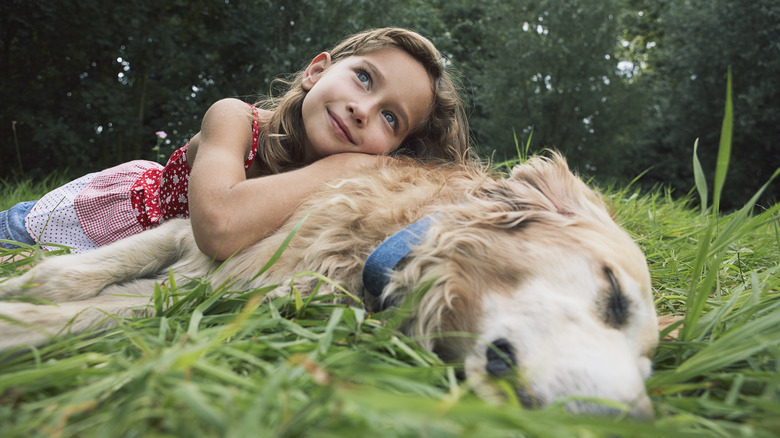Here's What It Could Mean If Your Dog Chases Its Tail
There goes your dog. It's taken off, sprinting across the park or your living room for a few seconds before settling down to the real business at hand: a twisting, turning, and gyrating battle to capture the furry tail that's been following it everywhere. Maybe you laugh with delight at this silly antic, or maybe you're hit by a sudden pang of concern. Why is your dog doing that? Is it alright?
The truth is that there are many reasons why dogs chase their tails, from a cheerful, happy, or silly dog blowing off a little steam to medical issues like parasites or neurological disorders. It can even be a symptom of doggie Alzheimers, and the challenge of figuring exactly what's going on in the doggie's brain in those moments has attracted some scientific notice. For example, a 2011 study published in PLOS One analyzed the nature of "canine tail-chasing" and human responses to it and ultimately suggested that some breeds, including bull terriers and German shepherds, might be more apt to tail-chase than others.
What is a concerned owner to do with a dog that's frequently in hot pursuit of its own hind end? When in doubt, consult with your vet. But knowing the many reasons why a dog might chase its tail can help, as can paying close attention to the context of the behavior. For example, is the tail-chasing constant, or does it only happen when your dog is obviously feeling silly? Can your dog be easily distracted from its tail, or does it seem fixated? Does it show any other signs that might be interpreted as physical or mental distress? Let's break down all of these reasons.
Your dog is silly and has fun chasing its tail
While there isn't any scientific evidence to say exactly how often tail-chasing turns out to be harmless canine fun, there's a whole lot of anecdotal evidence that this is frequently the case. Just consider the 400 online videos analyzed by the aforementioned PLOS One study, which was particularly notable because it represented an opportunity to review tail-chasing activity in a non-clinical setting.
Or, to put it another way: If the researchers had only analyzed dogs that were seen for tail-chasing in clinical settings like the vet's office, that sample might have skewed toward dogs that had a medical reason for that behavior. After studying online videos from everyday situations, the researchers concluded that they could observe clinical reasons for tail-chasing in about one-third of the videos, but those underlying causes went unnoticed by the dogs' human owners. The other two-thirds of the dogs might've just been having fun or burning off excess energy. And wouldn't you consider doing the same if you happened to come with a fluffy, waggy, and attention-grabbing toy attached permanently to your backside?
There's another totally benign reason your dog might be following its tail around: A puppy's early existence is all about discovery. If your dog is very young, it might still be trying to figure out what, exactly, that fluffy thing that's been following it around is.
Your dog thinks you approve when it chases its tail
If you can't help but laugh and smile when your dog chases its tail, or maybe you can't hold back a scolding, you may have unintentionally taught your dog that chasing its tail nets a reward. That's right: While treats, food, and playtime may be the most-obvious motivators for your dog, simply paying attention to it, whether positive or negative, can be a reward, too.
"Even negative attention, such as a reprimand, might be considered by the puppy as positive attention," explained Dr. Jerry Klein, chief veterinarian of the American Kennel Club (AKC), in an interview for the AKC's blog. And as researchers in the PLOS One video study found out, many owners are completely unaware that they're encouraging their dog's tail-chasing behavior. Some even criticized their dogs, calling them stupid when, in fact, the dogs were smart enough to figure out exactly which behavior drew attention from their humans.
If this is what's been happening in your home, here's some great news: This is a golden opportunity to play with your dog because it obviously prizes attention and interaction from you. And if you want to train your dog to chase its tail on command, you're already most of the way there. You just need to help it build an association between whatever word or gesture you want to be the cue and the reward of your attention. Or, if you want your dog to stop chasing its tail, you could train it to perform another behavior — like sitting or raising its paw — when it wants attention from you.
Your dog chases its tail because it's bored
Dogs need both mental and physical stimulation to be healthy and happy — and to stay out of trouble. While every dog is an individual, some dog breeds are famous for being particularly active. That can make them a great match for equally active humans, but if your dog isn't getting enough stimulation in its life, chasing its tail is just one of many ways it may fill the void of boredom.
One of the solutions to this dilemma starts before you even bring a dog home. Before adopting, it's always a good idea to do some research on a given breed's (or breed mix's) need for exercise and mental stimulation and learn everything you can about the dog as an individual. Foster owners and animal shelter workers are a great source of information for this because they've spent time with the dogs they care for and have some idea of how the dogs respond to various situations. Doing that research ahead of time helps ensure that you're finding the right dog for you and will be able to meet its needs for mental stimulation and enrichment.
But sometimes you don't realize your dog is bored until it starts chasing its tail. In that case, there's a lot you can do to keep your dog entertained, from taking it for more walks or runs to enrolling it in dog sports like scentwork, agility, or flyball. You can hire someone to walk your dog for you or take it to doggy daycare so it has a chance to socialize and burn off energy while you're at work. Lastly, you can always purchase or make toys or puzzles to keep your dog entertained.
Your dog has allergies that make its skin sensitive
If you've ever struggled with allergies, you already understand that environmental and food allergies can manifest in a number of interesting ways. That applies to dogs, too, which means that some dogs that chase their tails are actually in hot pursuit of an itchy body part. Other possible symptoms that your dog is experiencing allergies include red skin, a loss of fur, it rubbing its face on the floor or other surfaces, skin infections, and even gastrointestinal symptoms.
If you think allergies are behind your dog's tail-chasing, your vet will be your best ally in figuring out what's provoking the allergies and how to treat them. Much like humans, your dog might be allergic to dust, mold, certain plants, certain foods, or even fleas. Treatments may include changes in food or cleaning habits, employing a medication, or even using dog-specific shampoo or anti-inflammatory wipes to mitigate your dog's symptoms.
Your dog's tail is (or has been) injured
Just as your dog might be chasing its tail (or its hind end in general) because of itching, it might be chasing that elusive tail because of an injury. From skin infections to fractures, your dog could be working under the impression that catching the source of its discomfort will solve it. Some of the cues to look for that might indicate a tail injury, either acute or long past, include tenderness, discomfort, redness, and skin abnormalities, plus any changes in the way your dog carries its tail.
If your dog is actively bleeding around the tail or you suspect the tail might be fractured or broken — or if it shows any signs of severe pain or distress — it might be experiencing a medical emergency, and you should contact a vet immediately.
Your dog has fleas on its tail
You know what's guaranteed to generate a solid itch, no matter where they land? Fleas. And fleas generally love chomping down around a dog's tail, so an infestation might prompt your pup to chase that itch in hopes of nibbling it away. Look for signs of flea infestation by examining your dog's skin, looking for the fleas themselves or for the dark "dust" of their feces. A flea comb is useful for combing through your dog's fur to extract fleas, especially if its fur is thick.
Fleas are powerful jumpers, so if you do find any, dunk the flea comb into water to keep the pesky insects from escaping. Adding a bit of pet-safe soap to the water can help keep the fleas from sticking to the comb. As we know, some dogs are allergic to fleas, and symptoms can include redness, itching, and inflammation to the point that even a single flea bite can leave your dog itching for days.
Fortunately, there's a lot you can do to prevent or get rid of fleas on your pet if they show up on your dog or in your home. And as always, your veterinarian is a valuable ally in everything from choosing the right flea shampoo to identifying preventive treatments to keep the fleas from coming back.
Your dog has issues with its anal glands
As spectacular as your dog's fluffy tail may be, it's not the only thing going on in that region of the dog's body, and a few particular problems in the dog's backside may lead to tail-chasing. One of the most-likely possibilities is that your dog's anal glands, which sit on either side of the anus and are naturally expressed when your dog defecates, are in need of some TLC.
Cleaning your dog's anal glands isn't rocket science, but it's one of those jobs that most people would happily pay to let someone else do. That's where the trained professionals at your veterinary clinic, or some dog groomers, enter the picture. If you decide to express your dog's anal glands at home, keep in mind that any green, yellow, or white discharge — or chunky discharge, no matter the color — can indicate an infection. In that case, you definitely need a vet's help.
Or, your dog could have intestinal parasites
Intestinal parasites are another possible cause of itching in your dog's nether neighborhood that can lead to tail-chasing. Your dog is trying to catch that itch, just like all the other possible itches out there, and chew it out of existence. Other possible signs of intestinal parasites include bloating, low energy, a dull coat, unexpected weight loss, and licking at or scooting around on its backside.
Although worms are common intestinal parasites in dogs, they're not the only little critter that might try and make a move on your dog. It can potentially contract giardia, just as humans do, or a microscopic, single-cell parasite called coccidia.
If you suspect your dog has intestinal parasites, it is once again — you guessed it — time to contact your vet. Although intestinal parasites aren't necessarily life-threatening, a severe infection can become deadly if allowed to continue unchecked. Even if they don't become life-threatening, intestinal parasites can impact your dog's quality of life, and some can be transmitted to humans.
Anxiety and compulsive disorders can make a dog chase its tail, too
Dogs can develop anxiety issues much like humans do, so there's always the possibility that your dog's tail-chasing is an attempt to cope with its own anxiety much like a human might chew their nails in an effort to manage their own nervous system. Even if your dog isn't subject to overall anxiety, it might chase its tail in response to a bout of separation anxiety or because it's boiling over with hyped-up energy and doesn't know what else to do with itself.
As researchers observed in a 2022 study published in Frontiers in Veterinary Science, tail-chasing may be one of the "most common" compulsive behaviors in dogs. This compulsion may manifest as a nonstop obsession or a disturbing cycle of chasing and chewing at the tail until it becomes uncomfortable enough to prompt more chasing and chewing.
However, your vet can help. Possible treatments include antidepressants, training, and adjusting its environment to reduce or eliminate triggers. Depending on your dog's age, extra socialization might be helpful as well.
Seizures and other neurological disorders may result in dogs tail-chasing
Much as dogs can be subject to the same types of compulsive disorders and anxiety that affect people, they can also suffer from neurological disorders like seizures, and recognizing a seizure in your dog isn't always as straightforward as you might expect. For example, it's common for dog owners to mistake their dog's normal twitching behavior during sleep or shivering while cold or nervous as a sign of a seizure.
Those owners do have the right idea, though, because when your dog's brain receives a surge of uncontrolled electrical activity during the seizure, uncontrolled movements can result. Other possible symptoms of a dog seizure include seeming dazed, repeated uncontrolled movements of one body part (such as an eye twitching or a leg kicking), biting at the empty air in front of it, losing control of its bowels or bladder, and going stiff.
Head trauma, infection, cancer, low blood sugar or blood calcium levels, heatstroke, antifreeze poisoning, and exposure to recreational drugs are all among the possible causes of seizures in dogs. If you think your dog might be having seizures, it's vital that you speak to your vet so they can diagnose the cause and determine which treatments, if any, are appropriate. It's also worth noting that some breeds, including German shepherds, border collies, golden retrievers, and huskies, are typically predisposed to have worse seizures.
Perhaps canine dysfunction syndrome is causing your dog's tail-chasing
A dog that chases its tail might be very intelligent and happens to enjoy playing with its built-in toy, or it might be so smart that it's realized that chasing its tail will get some reward from you (like attention). With that said, tail-chasing can sometimes indicate a mental issue in a dog. For example, tail-chasing can be a symptom of canine dysfunction syndrome, which is more or less the doggy equivalent of Alzheimer's Disease. Or, it might happen in older dogs who aren't suffering from canine dysfunction syndrome but have reduced mental and sensory acuity due to their age.
Some other symptoms that might indicate canine dysfunction syndrome include toilet accidents, increased anxiety, decreased appetite and self-grooming, disorientation, and general shifts in how your dog responds to you and other household members. Possible treatments range from medication to training for behavior modification. As always, it's important to speak to your vet because there may be other underlying medical issues that contribute to your dog's apparent loss of mental acuity.
Sometimes, a dog's tail-chasing is a mystery
If you've done your due diligence, running down every potential reason why your dog might be chasing its tail and coming up with no answers, congratulations: You have a mystery on your hands. As any veterinarian or vet tech will tell you, one of the biggest challenges of treating our furry friends is that they can't just tell you how they feel or why they're doing something, and that applies to tail-chasing, too.
The good news is that if you and your vet feel satisfied there is nothing physically, mentally, or emotionally wrong with your dog, and the tail-chasing isn't causing any real problems, then it's a benign mystery. All you have to do is kick back and enjoy the free entertainment. If your gut tells you something isn't right, though, please remember that you always have the option of getting a second opinion from another vet. Or, if your dog is medically fine but the behavior is stressing you or your dog out, a canine trainer or behaviorist could be a powerful ally in solving the mystery on your hands — or is that on your dog's tail?
Always consult your veterinarian before making changes to your pet's diet, exercise, or care. To find an accredited veterinarian in your area, you can search the American Animal Hospital Association's online database.
